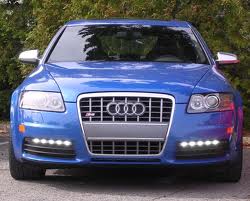Daytime Running Lights
Posted on
EU law requires that as from early 2011 all new cars will be required to be fitted with daytime running lights. Like those below)

Opponents argue that :-
It would increase fuel consumption and vehicle emissions;
It would lead to many more headlamp failures;
It could reduce the conspicuity effect of motorcyclists' voluntary use of dipped headlamps during the day; and
It could diminish the conspicuity of other vulnerable road users in general, such as cyclists and pedestrians.
However In countries that already have DRL legislation, it was found that the opposition against DRL greatly subsided and that acceptance levels were generally high after its implementation. This can be said of experiences in Denmark, Sweden, Norway and Canada.
For the time being, Canada is the only country requiring the installation of DRL as mandatory equipment in all vehicles. A Canadian study comparing 1990 model year vehicles (the first ones to be required to have DRLs) with 1989 vehicles estimated a statistically significant 11% reduction in daytime multiple-vehicle crashes other than rear end impacts.
DRLs were first made compulsory in Finland in 1972, and have since become law in a handful of other countries, including Canada, Denmark, Hungary, Iceland, Norway and Sweden. For much of the 1980s and 1990s imported Volvos and Saabs were all that most of the rest of the world saw of daytime running lights, but the trend has started to move south.
Now the laws in comparatively bright nations such as Italy and Israel require daytime running lights in certain weather conditions. Dipped lights are recommended in Sweden and Australia, and the French government advises drivers to use them on motorways. Even in Spain, Germany, Japan and the UK, where governments have so far held back on legislation, an increasing number of car manufacturers are offering DRLs as standard or as an optional extra on their flashier models.